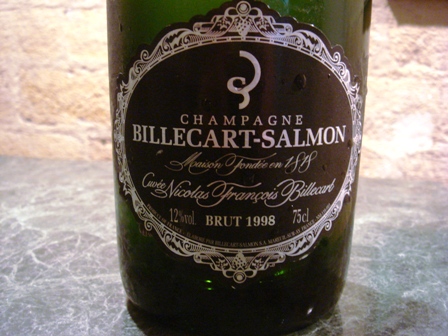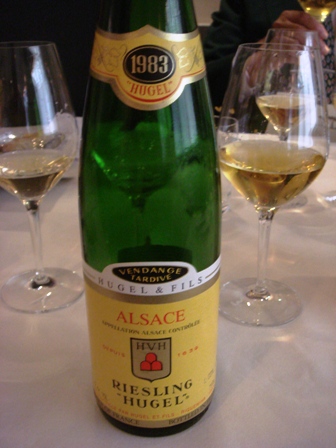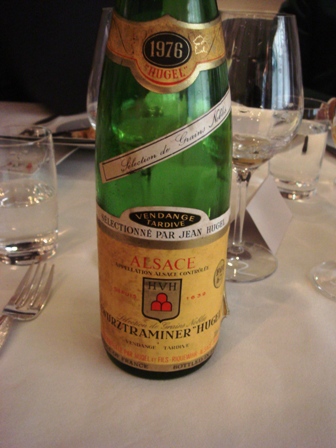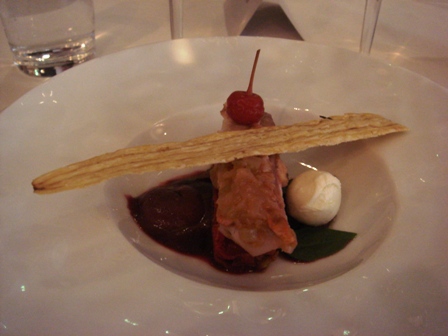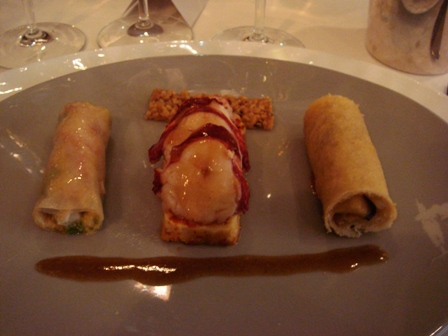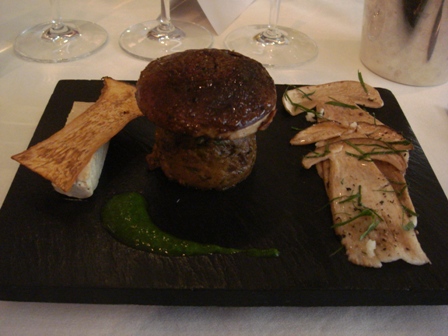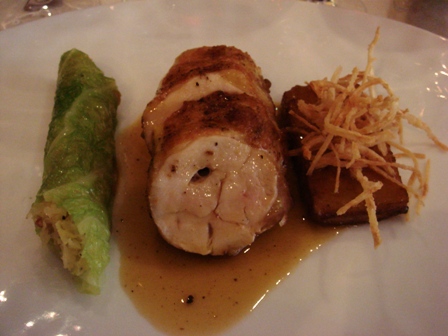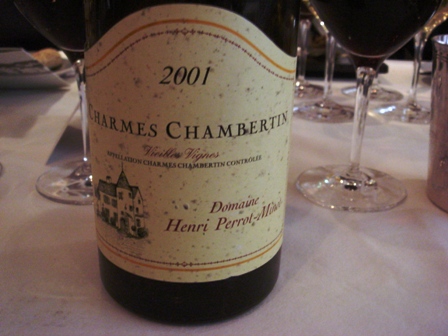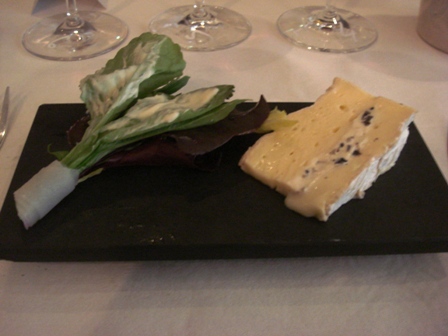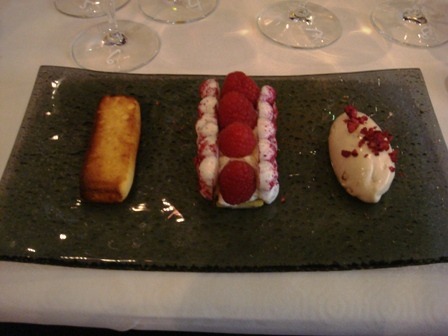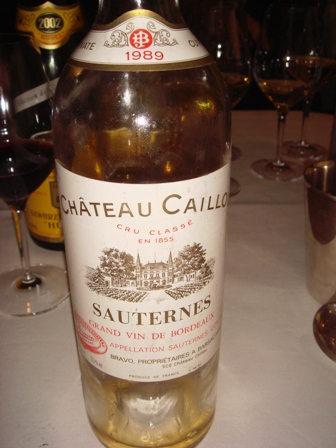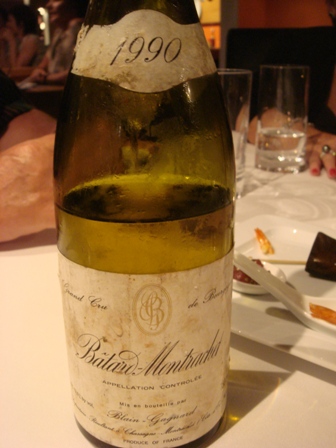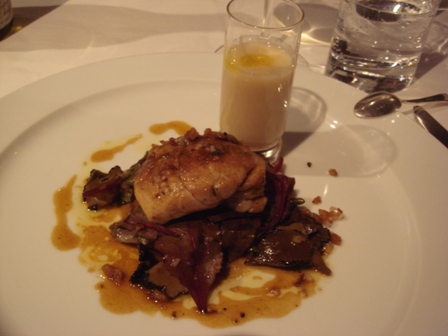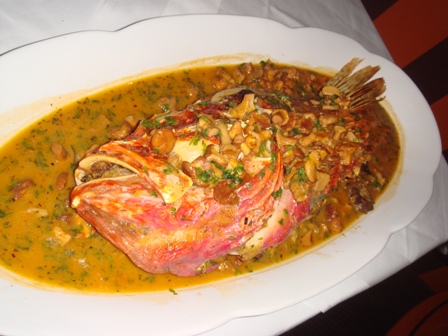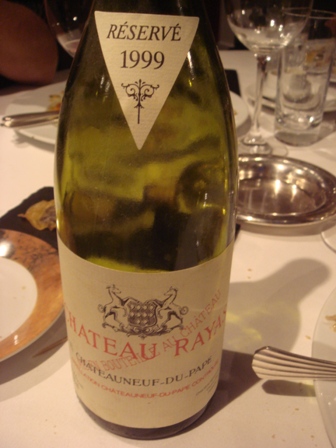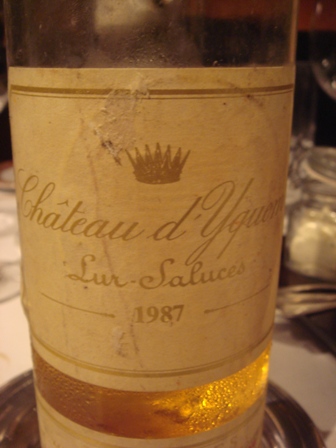Bipin Desai is an American collector of fine wines who organises magnificent events about specific wines. I attended verticals of Yquem, Pichon Longueville Comtesse de Lalande, Montrose, Angélus, Lynch-Bages, Trimbach, Léoville-Barton and Langoa Barton for which I made reports. When these events are held in Paris, it is usually by restaurant Taillevent. As it is my first event in Paris after a break of nearly three months, it is the best possible solution to acclimate myself again to Paris in this wonderful place. Jean Claude Vrinat welcomes us with his legendary smile, and, on the first floor, in the small Japanese salon, we drink a champagne Taillevent, which is a Deutz non vintage, a little dosé, but easy to drink with the very tasty “gougères”.
I meet people who are used to attend these events, writers or journalists on wines, auctioneers, sommeliers, wine merchants and some friends of Bipin. We are 32 people to drink 30 wines, and the guest of honour is John F. Kolasa, who is in charge of the two wines that we are going to drink to night. We talk, standing with our cup of champagne, and at 10 pm we are still not asked to go to the dining room. Knowing the program, I am a little afraid that it would last long. It did, as we left our table after 2 am.
The menu created for this event is : ravioli de champignons du moment, velouté de cèpes / bar de ligne poêlé, bouillon parmentier / canard colvert rôti à la rouennaise / fromage de nos provinces / croustillant de quetsches à l’Amaretto. It is as usual a very elegant cook, with a very precise definition, but the duck was not exactly cooked as the very late service of the dishes disorganised the kitchen.
When we enter the dining room, whose charm cannot be paralleled, there is a very curious smell in the room, as the one that exists in chais, as the 288 glasses of the first flight, which are already on the tables, give this smell. Serena Suttcliffe had the same surprise as me. Fortunately this curious smell did not indicate any defect of the wines.
We are going to have four flights. The first concerns Rauzan-Ségla 2005, 2000, 1996, 1995, 1988, 1982, 1970, 1966, 1961. My notes are taken very quickly as I tried to catch the first impressions. I came back to the same wines for another try, but I had not as time as I used to have as at our table of French speaking people, we talked and talked and smiled.
The Rauzan-Ségla 2005 has a smell which evokes cream or milk. In mouth it is very green but very promising. Herbaceous, deep, it is a great wine.
The Rauzan-Ségla 2000 has a nose which is already structured. It is serene. In mouth, there is a strong material combined with an elegant airiness. Slightly bitter, it lets a long trace in mouth. At this point I notice that the temperature of the wines for tasting is ideal.
The Rauzan-Ségla 1996 has a deep and elegant nose. In mouth I notice a constant skeleton in the structures of the wines, which is the terroir’s trace. This wine is a little bitter, lacks of balance and of length.
The Rauzan-Ségla 1995 has a discrete nose and an elegant taste. Slightly bitter but delicate, I like the persistency in mouth.
The Rauzan-Ségla 1988 has a confidential smell but which shows the intensity of the body of the wine. It is a little muddy. The taste is slightly acidic. There is some red fruit. The wine is a little short and has an acidic final.
The Rauzan-Ségla 1982 has the first smell which begins to show signs of evolution. The colour is a little orange brown. The taste shows also signs of evolution. The wine is a little light but has a smart consistency.
The Rauzan-Ségla 1970 has a nice and powerful nose. It is very nice in mouth and would require some food to really express all its potential. The balance can be imagined but the wine needs too much a food partner.
The Rauzan-Ségla 1966 has a lovely nose and a nice colour. The taste is a little imprecise and the wine lacks of balance.
The Rauzan-Ségla 1961 has a delicate and handsome smell. In mouth the wine is quite bitter and shows tiredness.
At this stage of the observation, having not had food to appreciate better some wines, it appears that the young wines, the more recent, put a little shadow on the older wines which lack a little of expansion. I like the 2000, the 1995 and the 2005. Revisiting the wines, I like the 1966 and the 1970 when they are accompanied by food. The 1988 is nice, just that, and the deception comes from 1982 and 1961, because one would expect more from these great years. The 2000 is a great wine to keep in cellar, as it will become very great, and the 2005 will become a very great wine. It is really well made. The 1966 that I had not so nicely judged at the first try remains very satisfying during all the time we can try this flight.
Bipin Desai has asked that each flight would be commented by a guest of French culture and by a guest of English culture. He has designated for the second flight David Peppercorn for the English comment, and myself for the French side. David is a talented writer on wine who has an encyclopaedic knowledge, and knows in advance what every vintage should give. It is interesting to notice that our analyses have been very different. Who is right ? Certainly David, as he has an experience that I have not, but by this exercise, I have learned a lot about the Anglo-Saxon approach of wines.
The second flight concerns : Rauzan-Ségla 1990, 1989, 1986, 1985, 1957, 1952, 1947, 1929.
The Rauzan-Ségla 1990 has a very pure nose. It is very different from the sensations of the first group as there is a taste of sherry that I did not notice in the previous wines. Acidic, it has a great length but does not please me so much.
The Rauzan-Ségla 1989 has a very pure smell too. It is very pleasant but I notice that something is lacking. This wine, as the 1970 requires food.
The Rauzan-Ségla 1986 has a deep smell. The wine is a little scholar. Once again, I feel that a strong tasty meat would enlarge the wine, which is a good sign if a wine demands food.
The Rauzan-Ségla 1985 has a rather tired nose. The wine has too much evolution. There is might, tastes of prunes, and for me a certain lack of charm.
The Rauzan-Ségla 1957 has a smell which shows some evolution, but it is interesting. We enter in a world of wines that I practice and like. Even if now and then one could find that not everything is perfect in this wine, it is exciting. A Burgundian aspect is not to displease me.
The Rauzan-Ségla 1952 has also a nose with signs of evolution and a lot of charm. The taste is male, evokes meat and game, and is wonderful with food. This is a wine that I like particularly.
The Rauzan-Ségla 1947 has a very elegant smell. The acidity is very pleasant. It is a great wine that I like.
The Rauzan-Ségla 1929, from the two bottles which are shared for all the attendants, is too acidic, too tired to be pleasant. I expected an improvement, but even if it began, there was no significant recovery.
On the fish, the 1986 is delicious. The 1990 is velvety and sweet, contrarily to the first impression. The 1989 is broad, virile, the 1986 is a synthesis of the 1989 and 1990. The 1985 is a little unfriendly to me but goes well with the mushrooms, as the 1957. The 1952 is splendid and better than the 1947, less brilliant as time flies. The 1929 improves a little. To classify these wines is difficult, but I appreciate perhaps a little more the 1986 and the 1952.
This vertical shows that Rauzan Ségla has lived periods in history where the wine had some weaknesses. Under the leadership of John Kolasa, new president of the property, this wine comes back to the glory that it had in the decade 1920-1929. This has been shown very brilliantly.
At my table are Neal Martin, who joined recently the team of Robert Parker and has his own forum, Michel Bettane, whose guide makes sensation in wine circles, Raoul Salama who writes for Revue du Vin de France, and some other famous persons. We talk a lot while studying the wines, in a very smiling atmosphere. It is after midnight when the second wine to taste appears on our tables, made by John and belonging also to the family Wertheimer.
The third flight concerns Château Canon Saint-Emilion 2005, 2000, 1982, 1961*, 1959*, 1949*, 1947. The sign “*” indicates that the wines were served from magnums and not from bottles as it was mostly the case.
In the Château Canon 2005 everything is « soft ». The impression which comes to my mind is the one of a motor of a Rolls Royce turning at 1000 rpm.
The Château Canon 2000 is very strict. It is a highly promising wine and one can expect a lot from this wine.
Very curiously, the word which comes to my mind concerning the Château Canon 1982 is exactly the same : “promising”, and it makes a great contrast with the Rauzan-Ségla 1982 which was too much evolved.
We continue in the same line of impressions, as I find that the Château Canon 1961 has a minimum of thirty years left to continue to be extremely brilliant.
The Château Canon 1959 is absolutely fabulous. I adore it, as it is a wine round and full of joy.
The Château Canon 1949 is astringent and acidic.
The Château Canon 1947 is a dream, of a pure perfect definition.
For me, the 1959 is above the 1947. I find it absolutely gorgeous. This flight shows a great contrast between Château Canon and Rauzan Ségla, the Saint-Emilion being more structured to perform on a long term than the Margaux.
The fourth flight concerns Château Canon 1998, 1990, 1989, 1964*, 1955*, 1952.
The Château Canon 1998 has a nice structure but is not particularly seducing.
The Château Canon 1990 is a great wine, pure and solid. At this time, after one am, my notes begin to be simplified, but keep the dominant impression.
The Château Canon 1989 is nice and solid, a little less charming than the 1990.
The Château Canon 1964 seems to be smoky, powerful, a great wine for gastronomy.
The Château Canon 1955 is a great wine, a little bitter but great.
I write for Château Canon 1952 this is wine !!! There are notes of coffee. I like this taste.
Château Canon offers obviously many greater years than Rauzan-Ségla. The tasting is interesting as it shows the progress made in both properties on the most recent wines. It should be stressed anyway that the two more recent years that we tasted are 2005 and 2000, which are years gifted by nature.
The success is there, and every young collector can already consider that in twenty to thirty years, he will drink wines which will reach the quality of the legendary wines of the twenties. Good luck to John Kolasa to continue in this positive trend.
